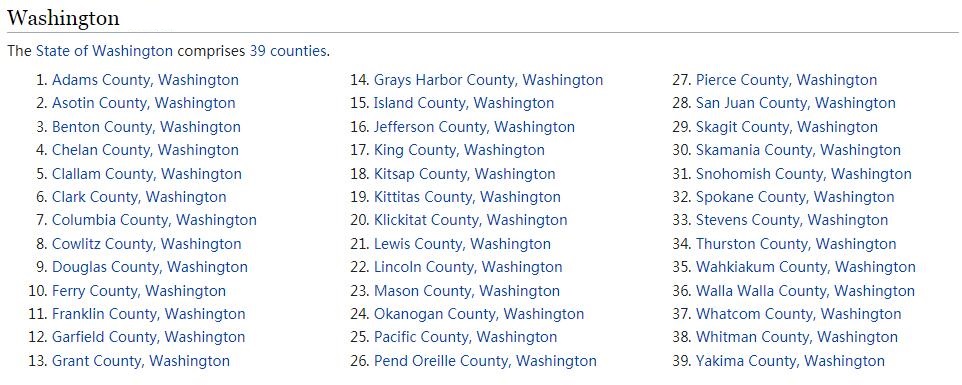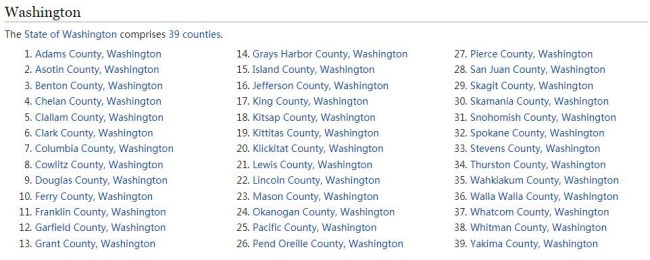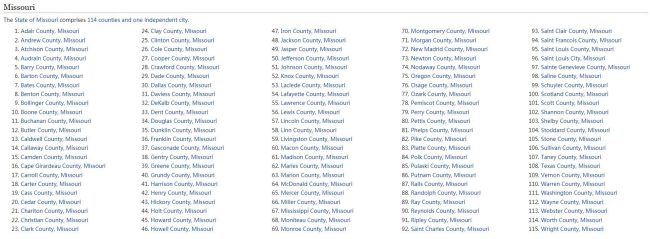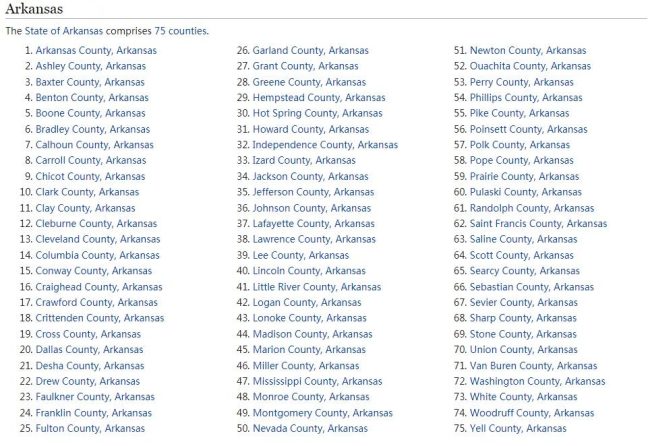Washington is one of the fifty states of the United States of North America. The state is located in the Western region of the United States and has a population of 6,830,038 (2011). The capital is Olympia and the state abbreviation is WA.
Washington formally became the 42nd state of the United States on November 11, 1889. The state is named after George Washington, the first US president.
The state borders Idaho to the east and Oregon to the south. To the north, Washington borders neighboring Canada. In the west, the state lies on the Pacific Ocean.
The bay of Puget Sound, on which the city of Seattle is located, opens onto the Pacific Ocean via the Strait of Juan de Fuca.
Two mountain ranges run through the state from north to south. These are the Pacific Coast Range and the Cascade Range. The highest point in the state at 4,392 meters is the summit of the volcano Mount Rainier.
Along the Pacific coast from south to north are the Willapa Hills and the Olympic Mountains. Mount Olympus has a height of 2,415 meters.
The Cascade Range divides the state into an eastern and a western part. Along the eastern edge of this plateau runs a large fault, on which volcanoes have formed.
The highest peaks are Mount Rainier, Washington’s highest point at 4,392 meters, the Liberty Cap (4,301 meters) and Point Success (4,313 m).
The western slope of the Cascade Range is heavily forested. The eastern slope consists of unforested radial ridges that descend into the Columbia Basin.
The eastern part of Washington is occupied by the Columbia River basin. This is the Columbia Basin.
To the north is the unforested Okanogan Mountains, to the southeast are the forested Blue Mountains with peaks reaching heights of nearly 2,000 meters.
In the south of Washington is the active volcano Mount Saint Helens.
Lakes and Rivers
Washington’s main river is the Columbia River, which has its source in Canada. Because the tributaries have cut deeply into the lava plateau, canyons have formed in many places.
Two other major rivers flow into the Columbia River. These are the Spokane and the Snake.
Major lakes in the state include Lake Chelan and the reservoirs behind Columbia River dams, such as Franklin D. Roosevelt Lake, at Grand Coulee Dam, and Banks Lake, at Dry Falls Dam.
Climate and holidays
Washington has a moderate maritime climate in the west. Most precipitation falls here in the winter.
The eastern part of the state has a continental steppe climate.
Major tourist attractions in Washington include the Olympic National Park, North Cascades National Park, and Mount Reinier National Park.
In addition, there are historic attractions such as Whitman Mission National Historic Site at Walla Walla, Fort Vancouver National Historic Site, San Juan Island National Historical Park, and the Makah Cultural and Research Center.
Cities Washington
Besides the capital Olympia are a number of cities in the state of Washington: Seattle, Spokane, Tacoma, Vancouver, Bellevue, Everett.
Spokane Valley, Federal Way, Kent, Yakima, Renton, Bellingham, Auburn, Kennewick, Lakewood.
Counties Washington
Washington is divided into 39 counties.
Whitman Mission National Historic Site
Located west of Walla Walla, Washington, Whitman Mission National Historic Site stands on the site of the former Whitman Mission on Waiilatpu. On November 29, 1847, the family of Dr. Marcus Whitman and other people massacred by the original Cayuse Indian tribe. The place is reminiscent of Marcus and Narcissa Whitman, who contributed greatly to the development of the famous Oregon Trail and tried to resolve conflicts between two different cultures – Indians and white settlers.
In 1836, a small group of Presbyterian missionaries also traveled to Oregon Country with the fur trappers. Among them were Narcissa Whitman and Eliza Hart Spalding, who were the first white women to travel across the continent. Differences in culture led to ever-increasing tensions between the Native Americans and the Whitman family. More and more white settlers came to the region, taking their land from the Indians.
In 1847, a measles epidemic also broke out, which killed about half of the Cayuse Indian tribe. Of course, the Indians blamed white immigrants for the deaths of their loved ones, especially Dr. Whitman, who was eventually killed along with his wife and eleven other people. About 60 other people were taken hostage by the Indians. This act shocked the entire country and the US Congress decided to defend the Oregon Territory and started a war with the Indians.
Today, the area is an important archaeological site where important artifacts dating back to that time have been excavated. About fifty years after the event, a commemorative obelisk was erected on a nearby hill. In 1936, a conservation area named the Whitman National Monument was established here, and on January 1, 1963, it was listed on the National Register of Historic Places.



